
Japan is an archipelagic country comprising a stratovolcanic archipelago over 3,000 km (1,900 mi) along the Pacific coast of East Asia. It consists of 14,125 islands. The five main islands are Hokkaido, Honshu, Kyushu, Shikoku and Okinawa. The other 14,120 islands are classified as "remote islands" by the Japanese government. The Ryukyu Islands and Nanpō Islands are south and east of the main islands.

Hokkaido is Japan's second largest island and comprises the largest and northernmost prefecture, making up its own region. The Tsugaru Strait separates Hokkaidō from Honshu; the two islands are connected by the undersea railway Seikan Tunnel.

Honshu, historically called Akitsushima, is the largest and most populous island of Japan. It is located south of Hokkaidō across the Tsugaru Strait, north of Shikoku across the Inland Sea, and northeast of Kyūshū across the Kanmon Straits. The island separates the Sea of Japan, which lies to its north and west, from the North Pacific Ocean to the south and east. It is the seventh-largest island in the world, and the second-most populous after the Indonesian island of Java.

"Mainland Japan" is a term used to distinguish Japan's core land area from its outlying territories. It is most commonly used to distinguish the country's four largest islands from smaller islands such as the Ryukyu Islands and Ogasawara Islands, although depending on the context the term "Mainland Japan" might refer only to Honshū, the largest island.

The Tsugaru Strait is a strait between Honshu and Hokkaido in northern Japan connecting the Sea of Japan with the Pacific Ocean. It was named after the western part of Aomori Prefecture. The Seikan Tunnel passes under it at its narrowest point 12.1 miles (19.5 km) between Tappi Misaki on the Tsugaru Peninsula in Aomori Prefecture, Honshu, and Shirakami Misaki on the Matsumae Peninsula in Hokkaido.

The Japanese archipelago is an archipelago of 14,125 islands that form the country of Japan. It extends over 3,000 km (1,900 mi) from the Sea of Okhotsk in the northeast to the East China and Philippine seas in the southwest along the Pacific coast of the Eurasian continent, and consists of three island arcs from north to south: the Northeastern Japan Arc, the Southwestern Japan Arc, and the Ryukyu Island Arc. The Daitō Islands, the Izu–Bonin–Mariana Arc, the Kuril Islands, and the Nanpō Islands neighbor the archipelago.
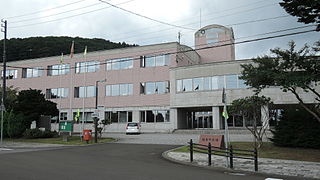
Fukushima is a town located in Oshima Subprefecture, Hokkaido, Japan.

Enbetsu, also known as Embetsu, is a town located in Rumoi, Hokkaidō, Japan. As of 2013, the town had an estimated population of 2,966 and a density of 5 persons per km². The total area is 590.86 square kilometres (228.13 sq mi). The town is bisected by the Enbetsu River, which flows from the Teshio Mountains directly into the Sea of Japan. Enbetsu is the northernmost area of rice production in Japan.

The Tsugaru Peninsula is a peninsula in Aomori Prefecture, at the northern end of Honshū island, Japan. The peninsula projects north into the Tsugaru Strait separating Honshū from Hokkaidō. The western coast is on the Sea of Japan, while on its eastern coast are Aomori Bay and Mutsu Bay. The peninsula is bisected from Cape Tappi at its northern end to the Hakkōda Mountains on its southern end by the Tsugaru Mountains. Across the Tsugaru strait to the north is Hokkaidō's Matsumae Peninsula, to which it is linked by the Seikan Tunnel.
The wildlife of Japan includes its flora, fauna, and natural habitats. The islands of Japan stretch a long distance from north to south and cover a wide range of climatic zones. This results in a high diversity of wildlife despite Japan's isolation from the mainland of Asia. In the north of the country, north of Blakiston's Line, there are many subarctic species which have colonized Japan from the north. In the south there are south-east Asian species, typical of tropical regions. Between these areas lies the temperate zone which shares many species with China and Korea. Japan also has many endemic species that are found nowhere else in the world, making it home to many endangered/rare species.
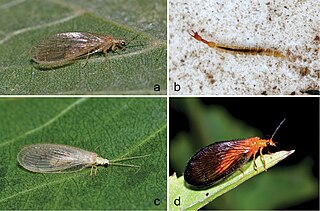
The Nevrorthidae are a small family of winged insects of the order Neuroptera. Extant species may be described as living fossils. There are 19 extant species in four genera, with a geographically disjunct distribution: Nevrorthus, comprising 5 species with scattered distributions around the Mediterranean; Austroneurorthus, with two species known from southeastern Australia; Nipponeurorthus, comprising 11 species known from China and Japan; and Sinoneurorthus, known from a single species described from Yunnan Province, China. They are traditionally placed in the Osmyloidea, alongside Osmylidae and the spongillaflies (Sisyridae), but some research has considered them to be the sister group to the rest of Neuroptera. The larvae have unique straight jaws that are curved at the tips, and live as unspecialised predators in the sandy bottom sediments of clear, fast flowing mountain rivers and streams. They pupate underwater on the underside of stones. The adults are likely predators or feed on honeydew and other sugar-rich fluids.

The 2003 Hokkaidō earthquake, scientifically named the 2003 Tokachi-Oki earthquake, occurred off the coast of Hokkaidō, Japan on 26 September at 04:50 local time. At a focal depth of 27 km (17 mi), this great undersea earthquake measured 8.3 on the moment magnitude scale, making it the most powerful earthquake of 2003, as well as one of the most intense earthquakes to hit Japan since modern record-keeping began in 1900.
The HVDC Hokkaidō–Honshū or Hokkaidō–Honshū HVDC Link, Kitahon HVDC Link for short, is a 193-kilometre-long (120 mi) high voltage direct current transmission line for the interconnection of the power grids of Hokkaidō and Honshū, Japan. The project went into service in 1979 by the Electric Power Development Company (J-POWER). A 149-kilometre-long (93 mi) overhead line and a 44-kilometre-long (27 mi) submarine cable connect the terminals. The HVDC Hokkaidō–Honshū is a monopolar HVDC line with an operating voltage of 250 kV and rated power of 300 megawatts. This HVDC system uses thyristor converters.
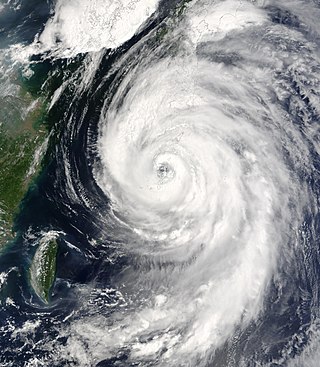
Typhoon Etau, known in the Philippines as Typhoon Kabayan, produced near-record winds and rainfall in Japan in August 2003. The tenth named storm and fifth typhoon of the 2003 Pacific typhoon season, Etau developed on August 2, and gradually intensified while moving to the northwest. Etau formed an eye and became a large storm by the time it approached Okinawa on August 7. The typhoon attained peak winds of 155 km/h (96 mph) before weakening slightly while turning to the northeast. Etau made landfall on the Japanese island of Shikoku on August 8, and later moved across portions of Honshu and Hokkaido. After weakening to tropical storm status, the cyclone became extratropical on August 9 and dissipated three days later.
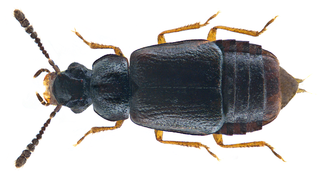
Omaliini is a tribe of ocellate rove beetles in the family Staphylinidae. There are about 45 genera and 450 described species in Omaliini.
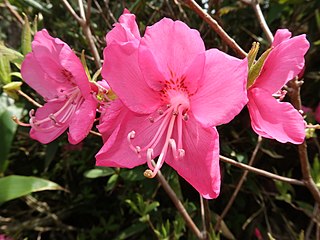
Rhododendron albrechtii is a species of flowering plant in the family Ericaceae. It is endemic to Japanese temperate rainforests. Native of central and northern Japan; described from specimens collected in the 1860s by Michael Albrecht of the Russian Consulate at Hakodate, for whom the species is named.
Hemerocallis yezoensis is a species of plant in the genus Hemerocallis, native to eastern Hokkaido and the southernmost extremities of the Kuril Islands.
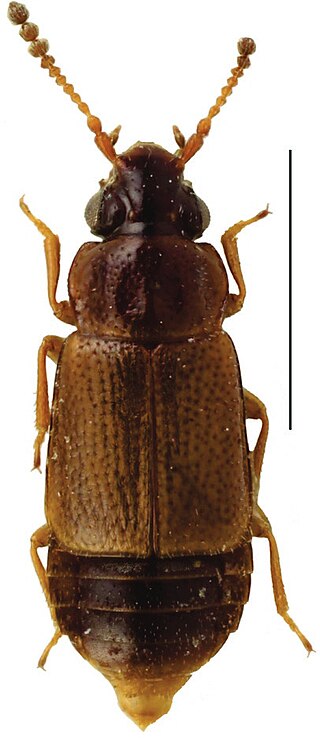
Carcinocephalus is a genus of rove beetles in the family Staphylinidae, subfamily Omaliinae.
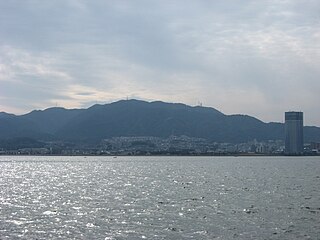
Otowayama Tunnel is a tunnel on JR's Tokaido Shinkansen located between Kyoto city and Otsu City, Shiga Prefecture with total length of 5.045 km. It was built and completed in 1964.















